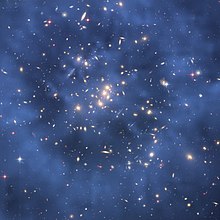Science Fiction Challenge

Science Fiction Challenge is a learning project for exploring the nature and boundaries of science through science fiction writing. What does it mean to say that the subject of scientific study is "nature" and what does it mean to talk of the "supernatural"?
Project background
[edit | edit source]Do some "age old ideas" rest upon a hidden foundation of science? Ideas about "supernatural" phenomena have long been popular in fiction, but science fiction generally avoids topics such as the "supernatural". Arthur Clarke suggested that "Any sufficiently advanced technology is indistinguishable from magic," so how do we know that science can not reveal explanations for "supernatural" phenomena? Can fiction writing play a useful role in stimulating scientists to "think outside the box" and provide us with "missing explanations" for supernatural phenomena?
The "Science Fiction Challenge" originated from discussion at Science and the nonphysical where it was suggested that scientists are unlikely to discover explanations for supernatural phenomena because they assume that such things as "nonphysical spirit" only exist in the imagination. An alternative possibility is that scientists have low levels of interest in supernatural phenomena because past experience has shown that it is hard to make scientific progress on studies of supernatural phenomena. The "Science Fiction Challenge" calls for the creation of fictional accounts of how scientific studies might some day bring seemingly supernatural phenomena within the boundary of what can be studied and understood scientifically.
Oriental religions and philosophy do not all seem to have the boundaries of the Western mind-body problem. Some of them, those based on the qi concept talk about an energy that pervades all of physical reality (energy and matter) and is a type of spiritual energy. That spiritual energy is similar to the Western concept of spirit, something that Western Science has not been able to understand or experiment with. Using those concepts and handling that qi energy, some people try to cure ailments and perform martial arts. Science fiction can explore topics commonly seen in Oriental philosophies from the perspective of a future society where there have been scientific advances unknown to us and where there are new ways of merging science and spirituality.
Writing projects
[edit | edit source]
- Mnemtronium - set in an imagined future after dark matter is fully understood. It is discovered that dark matter provides a way to account for some forms of Extra-sensory perception.
- The nanoepitaxy of Susanne Marie - explores the idea that there might be evidence for extraterrestrial life that can be found right on Earth....if we knew where to look and what to look for. Could extra-terrestrials with advanced technology have built seemingly supernatural abilities into Earth's life forms?
- No Working Title - In 1948 Arthur C. Clarke published Against the Fall of Night, a story in which he imagined Earth of the far future when the residents of the city Diaspar were essentially immortal and there were few children. From our perspective in the year 2015, what kind of future can we foresee for Earth? Given technological tools for genetic engineering and artificial intelligence, will the human species last for long or will we create our own replacements? Would a new form of life created by humans have a soul?
- 2540 - this story explores nanorobotics as a future technology that provides an example of Clarke's Third Law. If nanites were present and active on Earth, how could we distinguish their effects from magic?
- Singularity - Magho'ple discovers that she is inside a simulated reality. Can she escape from the simulated reality and exist as an artificial life form in the real world?
- The search for Kalid (external link): a futuristic story which explores the boundaries of mind and machines with respect to telepathy and matter hiding devices.
- Admiring Odin - Ancient astronauts, Alec and Odin, are two aliens who visit Earth. Alec is a Grendel who must work with Odin to genetically modify the people of Europe so as to remove the Neanderthal genes that give them telepathic powers.
Literature review
[edit | edit source]
What existing science fiction stories provide accounts of how science might be able to incorporate elements of the supernatural into a scientific world view?
- Ringworld by Larry Niven. Does Niven's idea of "breeding humans for luck" provide a valid scientific explanation for the mysterious phenomenon of "good luck"?[1].
- The Calcutta Chromosome by Amitav Ghosh - mix of hard science fiction with supernatural elements[2]. Do brain diseases and neuro-active drugs provide ways for materialistic science to reveal the mind's power to control supernatural forces?
- The Number of the Beast by Robert Heinlein postulates that the multiverse of quantum mechanics is waiting to be filled by thought particles from other universes. In an infinite series of infinities anything that can be thought becomes reality somewhere via these thought particles accumulating to previously empty universes.
- Contact by Carl Sagan. Sagan's novel explores this question: if our universe was created, then what objective scientific evidence might be found to support the idea that there was a Creator?
References
[edit | edit source]- ↑ Science Fiction Writers : Critical Studies of the Major Authors from the Early Nineteenth Century to the Present Day E.F. Bleiler, Ed. Charles Scriber's Sons, New York 1982.
- ↑ Postcolonial Science Fiction: Amitav Ghosh’s the Calcutta Chromosome by Claire Chambers in The Journal of Commonwealth Literature (2003) Volume 38, pages 58-72.
See also
[edit | edit source]| Subject classification: this is a science resource. |
- Fiction writing support group
- Science and the nonphysical
- Digital Storytelling
- Portal:Writing Center
- Fiction writing
Additional resources
[edit | edit source]- Is truth stranger than fiction?
